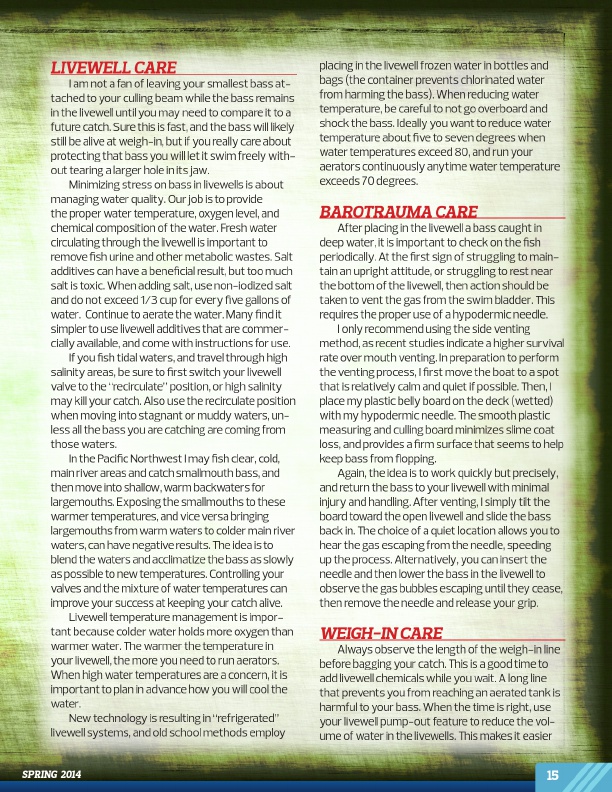
LIVEWELL CARE
I am not a fan of leaving your smallest bass at- tached to your culling beam while the bass remains in the livewell until you may need to compare it to a future catch. Sure this is fast, and the bass will likely still be alive at weigh-in, but if you really care about protecting that bass you will let it swim freely with- out tearing a larger hole in its jaw.
Minimizing stress on bass in livewells is about managing water quality. Our job is to provide the proper water temperature, oxygen level, and chemical composition of the water. Fresh water circulating through the livewell is important to remove fish urine and other metabolic wastes. Salt additives can have a beneficial result, but too much salt is toxic. When adding salt, use non-iodized salt and do not exceed 1/3 cup for every five gallons of water. Continue to aerate the water. Many find it simpler to use livewell additives that are commer- cially available, and come with instructions for use.
If you fish tidal waters, and travel through high salinity areas, be sure to first switch your livewell valve to the “recirculate” position, or high salinity may kill your catch. Also use the recirculate position when moving into stagnant or muddy waters, un- less all the bass you are catching are coming from those waters.
In the Pacific Northwest I may fish clear, cold, main river areas and catch smallmouth bass, and then move into shallow, warm backwaters for largemouths. Exposing the smallmouths to these warmer temperatures, and vice versa bringing largemouths from warm waters to colder main river waters, can have negative results. The idea is to blend the waters and acclimatize the bass as slowly as possible to new temperatures. Controlling your valves and the mixture of water temperatures can improve your success at keeping your catch alive.
Livewell temperature management is impor- tant because colder water holds more oxygen than warmer water. The warmer the temperature in your livewell, the more you need to run aerators. When high water temperatures are a concern, it is important to plan in advance how you will cool the water.
New technology is resulting in “refrigerated” livewell systems, and old school methods employ
placing in the livewell frozen water in bottles and bags (the container prevents chlorinated water from harming the bass). When reducing water temperature, be careful to not go overboard and shock the bass. Ideally you want to reduce water temperature about five to seven degrees when water temperatures exceed 80, and run your aerators continuously anytime water temperature exceeds 70 degrees.
BAROTRAUMA CARE
After placing in the livewell a bass caught in deep water, it is important to check on the fish periodically. At the first sign of struggling to main- tain an upright attitude, or struggling to rest near the bottom of the livewell, then action should be taken to vent the gas from the swim bladder. This requires the proper use of a hypodermic needle.
I only recommend using the side venting method, as recent studies indicate a higher survival rate over mouth venting. In preparation to perform the venting process, I first move the boat to a spot that is relatively calm and quiet if possible. Then, I place my plastic belly board on the deck (wetted) with my hypodermic needle. The smooth plastic measuring and culling board minimizes slime coat loss, and provides a firm surface that seems to help keep bass from flopping.
Again, the idea is to work quickly but precisely, and return the bass to your livewell with minimal injury and handling. After venting, I simply tilt the board toward the open livewell and slide the bass back in. The choice of a quiet location allows you to hear the gas escaping from the needle, speeding up the process. Alternatively, you can insert the needle and then lower the bass in the livewell to observe the gas bubbles escaping until they cease, then remove the needle and release your grip.
WEIGH-IN CARE
Always observe the length of the weigh-in line before bagging your catch. This is a good time to add livewell chemicals while you wait. A long line that prevents you from reaching an aerated tank is harmful to your bass. When the time is right, use your livewell pump-out feature to reduce the vol- ume of water in the livewells. This makes it easier
SPRING 2014
15